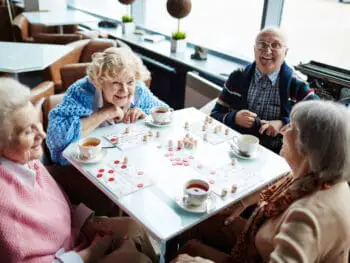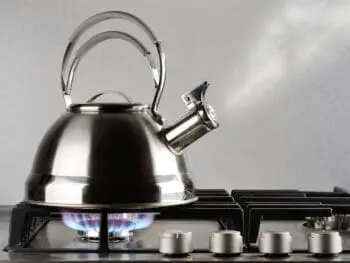In the last 10 years, there has been a shocking increase of over 30% in the number of deadly falls among seniors. And, if that is not enough to make you sit up and take notice, this little bit of information sure will – Over 80% of these falls occur inside the homes of older adults.
When you think about an elderly person falling down in the house, the bathroom, the kitchen and areas outside the house like the driveway and the patio come across as the riskiest.
While bathrooms pose the greatest risk, not too far behind are bedrooms, and in the third place, you have stairways. In fact, falls on the stairways can be the most dangerous of them all because multiple impact points are involved in such tumbles. Let me explain this further.
Why Are Stairways So Dangerous For Seniors?
1. That is one helluva drop
Often the person who loses his/her balance starts on the top deck or step and continues to tumble down till the fall is stopped on the landing. In effect, the senior is covering a distance of several feet in a matter of seconds.
Add the force of gravity and the person’s own body weight to this mix along with everything on and around the staircase, and it is easy to understand how such falls result in multiple injuries and fractures.
2. It is really easy to trip or lose your balance on the stairs
Not only are stairways more dangerous, but also they are hotspots for slipping, tripping and tumbling, unless they have been made to perfection. Unfortunately, that is seldom the case, which means that older adults are left to contend with steps of varying sizes and angles which can take anybody by surprise.
Actually, the variation in the rise of the stairs can even cause younger individuals to take a tumble, let alone older adults who have trouble folding their knees and lacks muscle strength in their legs.
3. Help can cost a bundle
The biggest problem is that fixes for dangers that lead to falls on the stairs come at a steep price. For instance, changing the surface/tiles or the angle of the steps can cost several thousand dollars depending on the type of house you live in.
Replacing the stairway with a ramp/building a home escalator can cost even more, which is beyond the reach of most.
Fortunately, there are a few products and tips which will only set you back by a small amount, and they are just as effective. Actually, unless a senior is unable to move around without a wheelchair, these tips and techniques should be enough to make the stairs safe for the elderly.
What Makes Older Adults Fall On The Stairway?

The reason I’ve included this section in the article is because it would be futile to make changes to factors that do not contribute to the risk level in the first place.
For instance, undertaking a complete remodeling of the stairway, which can cost you to the tune of thirty to fifty grand, would make no sense if your elderly parent has the habit of rushing up or down the stairs.
This section will help you to do a risk analysis. Take a look at the 4 factors that influence the possibility of taking a tumble down the stairs.
1. Environmental
Poor lighting around the stairways, slippery surface, cluttered steps and substandard treads are bound to cause trouble for anybody, whether young or old. Fortunately, these environmental factors can be dealt with easily and inexpensively.
2. Behavioral
Use of improper footwear, an inactive lifestyle that causes bone and muscle problems, lack of concentration, carrying objects up and down the stairs, not using recommended support devices when using the stairs can all greatly increase the risk of a fall on the stairways.
3. Structural
Uneven surface, steps that vary in height and depth, too many stairs, lack of a handrail and a higher than the normal angle of the stairway can make it hard for a senior to navigate his/her way through the flight of stairs.
4. Physical
Dizziness caused by medication, physical weakness, loss of understanding, impact on the movement of the legs and the leg joints, trembling, respiratory issues and cardiovascular problems can all make the stairway an exceptionally dangerous area of the home for seniors.
Of these four, environmental and behavioral problems can be remedied with ease. Structural issues can be handled, but they call for a significant investment. The hardest problems to deal with are physical issues.
In fact, if your elderly parents suffer from medical problems that pose a risk when they are using the stairway, I would recommend you take the simpler and safer option out by limiting and even eliminating their time on the stairway all together. That really is the only sensible thing to do in such a scenario.
Make The Easy Move If It’s An Option!
I am a big fan of simplicity if and when it’s an option. Particularly, where safety is concerned and if I can take the easier and safer route, I sure am all for it. So, in that spirit, here are the first few easy-peasy but surefire tips for avoiding the dangers presented by the stairway.
Get a professional assessment
I bet you think I am talking about calling in a home improvement expert here. WRONG! I am talking about a consultation with a physical therapist. Just because your elderly parents have no trouble walking on flat ground doesn’t mean the stairways are safe for them.
In fact, only a licensed physical therapist can make an accurate diagnosis of the possible risks of using the stairs. So, this should be your first step towards making the stairs safe for the seniors in your life.
The expert advantage
Apart from a professional analysis of the risk quotient, another distinctive advantage of paying for expert opinion is that the physical therapist will recommend exercises and therapy sessions to maintain and improve strength and flexibility.
So, if your parents don’t have a problem with the stairs, this is a fantastic way to ensure their safety on the stairs over the long term. If they do have health issues that can turn the flight of stairs into a dangerous place for them, the exercises will ensure that things don’t deteriorate to the point where walking anywhere is problematic and dangerous.
Lower the risk of a fall by minimizing stair-time
It goes without saying that the easiest and most effective solution to the dangers posed by the stairway is to refrain from using this design feature of your home.
If that means moving your elderly parent’s bedroom to the first floor or remodeling the work area to include a bathroom, then the safety offered by these home improvement interventions will certainly justify their costs.
How To Make Stairs Safer For Elderly With Behavioral Changes?

Sometimes, it may not be possible or even required to avoid the stairs entirely. In such cases, a few simple behavioral changes can help seniors to minimize the risk of a fall.
This is for all the older adults out there – Sure these behavioral changes will take some getting used to. But, remember that it’s your independence, physical and mental wellbeing and even your life at stake here.
Besides there is really nothing that you can’t learn with a bit of practice. Never underestimate the power of a habit and repetition folks. Plus, these are common sense tips. All you need to do is remind yourself to follow them judiciously. With that let me go to the first simple behavioral change:
Look where you are going
The brightest lights in the world will do little to help you stay safe if you don’t watch your steps or cannot see the stairs as clearly as you should. So, the first thing to do is keep your eyes on the stairs; no shame in looking down when walking.
If you wear glasses, make sure you have the right ones on. It is not uncommon for seniors to try to make their way up the stairs while their reading glasses remain firmly perched on their noses. My mom is definitely one of those older adults who puts the book down but forgets to take off her glasses.
It goes without saying that your reading glasses will impact forward visibility and greatly increase the risk of a fall. For my mother, I have made a small bookmark with a reminder on top that tells her to take off her glasses.
That said, you can try other options like putting up a small sign on the wall next to the stairway that reminds your elderly parents to use the right pair of glasses when climbing up or down the stairs.
Seniors you need to be extra careful if you are using bifocal or progressive lens glasses. It is easy to forget about your line of sight with these.
Don’t allow peeper problems to cause a fall
If you use prescription distance glasses, always have them on when using the stairs. Also, get your vision checked at regular intervals to ensure you always have the corrective eyewear you need.
Put your heart into the descent or ascent
Focus on the task at hand folks; now this is something that people around you can’t make you do. As far as possible, don’t occupy your hands when using the stairs. This means if you need to carry something up or down the stairs, get somebody else to do it.
At the least, keep one hand free to grab the hand rail, which will give you some amount of support and safety. Also, try not to make your way up the stairs with heavy stuff in your hands. The more weight you have in your hands, the more unsteady you will be on your feet and the harder it will be for you to balance yourself.
The right sole will also make a difference
Regardless of the type of flooring on the stairs, always wear non-slip footwear at home. Walking around barefoot or with your socks on can increase the risk of slipping on the floor. This next one is for all you older ladies out there – if you still enjoy and do wear heels, keep them off the stairs.
The important thing to understand here is that the type of footwear, heel height and shape as well as the sole tread, hardness and material will all impact your gait and balance. So, choose your footwear with great care.
No speeding on the stairway
Even if somebody is beating down the door or the phone refuses to stop ringing, there is no reason to rush down the stairs. Really, haste will lead to waste in this case!
So, take your time on the stairway, and climb up or down each step deliberately and slowly. Be extra cautious and grab on to the hand rails. If you have handrails on both sides of the stairs, put them to use, particularly if you are on stairways with rectangular and shorter treads.
How To Make Stairs Safer For Elderly With Simple Environmental Changes?

Clutter is dangerous
Clothes, books, shoes and small household items lying on the landing or the steps can be a very real tripping hazard. Plus they can be a distraction, which can cause a senior to lose his/her balance and fall back when trying to climb up the stairs. So, keep the stairway absolutely free of clutter.
Remove the hurdles
Furniture, lamps and other decorative objects or elements placed at the bottom or at the top of the stairs, which can get in the way, should also be removed. And while you are at it, also tackle loose rugs. All of these can be major tripping hazards.
Get the lighting right
In most homes, the stairway has fewer lights than the surrounding area. This immediately impacts your ability to see the steps clearly since it takes your eyes some time to adjust to the lower illumination.
Actually, you should be going for the exact opposite effect. You can either make sure that you have standard (make that bright) illumination in all areas of your home or make the stairs brighter by using lights specifically meant for the area.
No need for the blinding glare
The problem with overhead lights that are too bright is that they may cause glare, which can impact vision. So, opt for a mix of overhead and wall lights, which will enhance illumination on the stairway without giving your elderly parents a headache.
Switches in the right places
The right type and amount of lighting won’t help if you don’t have switches where they need to be. Because the stairway should be well illuminated all over, make sure that you have one switch at the top and another at the bottom.
This way, the lights can be switched on before the stairs are used. Having said that, if you are concerned about energy consumption, you can always opt for motion sensor lights.
Go for contrasts
This is another nifty trick to improve visibility and the perception of depth. Depending on the vision problems of your elderly parents and the type of stairs, just an improvement in lighting may not be enough.
However, creating a contrast between each step can certainly help. You can either do this by using wall lights of different colors for each step or by using non-slip/anti-slip strips in contrasting colors on each step or using two different stains.
Set the surface right
The biggest fall risk when it comes to stairways is the surface of the treads. If the material is smooth and glossy like marble, tile or wood, it’s a huge risk. Unfortunately, changing the treads may not be possible for everybody. But, you sure can install rubber or abrasive stick-on pads on the treads.
Another way is to use the anti-slip tape I discussed above. While abrasive/rubber mats will give you complete tread coverage, with the tape, which is just a bit wider than regular duct tape, you will have to use several strips to cover the entire surface area of the tread.
Make sure that each of these adhesive-back strips is properly fixed from wall to wall or from wall to balustrade/railing as the case may be. Don’t use anti-slip paint on the stairs. It can make the treads more slippery.
Deal with carpeted stairs
Carpets do, undoubtedly, offer a surface that is more abrasive than wood, marble or tile. But a loose carpet can be as much of a fall hazard as a smooth hard floor. So, either remove the carpet or make sure that it has no sag at all and that it sits tightly against the nosing of each tread.
You can’t do much to stop old, worn-out carpets from sagging. Plus they lose their abrasive edge over time. So, it’s best to remove them. If you intend to install new carpet on the stairs, opt for non-slip materials.
Polyester and olefin carpets are notoriously slippery, so stay away from them. Do not use a carpet runner. If you have one in place, it will be wise to take it off, particularly if your elderly parent has to use a cane for support.
Rails all the way
No other addition/change to the stairway can increase the safety quotient for older adults as much as handrails. The good thing is that in most homes the stairways do have a banister/railing and the handrail at least on one side.
However, when you have seniors at home, you can never be too careful. So, offer support on the other side as well with a wall mounted handrail. On both sides, ensure that the handrail is placed such that it is at elbow-height for your parents. Also, the rail itself (the part that you grip with your hands) has to be smooth but not slippery. It should have a diameter that would allow your parents to grip it completely.
If the pipe used for the rail is too thick, a senior will not be able to grab onto it properly, which means the handrail won’t offer as much support and safety as it should. That said, also make sure that the railing and the handrails are sturdy enough to support the weight of the seniors in your home. The handrails on both sides should start at the top of the stairs and cover the full length of the stairway to the landing, and a few feet beyond if possible.
A bit of rest can also help
If your stairs are designed to have a landing or a curve with enough room to accommodate a bench, this will be a fantastic safety addition to make. The bench does not have to be too wide and it should be placed such that it does not obstruct movement and is not a tripping hazard.
The idea is to offer a place where older adults, who have cardiovascular and respiratory issues or those with significant mobility and strength issues, can rest and catch their breath before continuing the ascent or descent.
And In Conclusion
Nearly 10% of all in-home falls in seniors occur on the stairs and most of them take place at the top or the bottom of the stairway. In both cases, older adults tend to suffer from serious and multiple injuries. So, this is certainly one area of your home that needs attention if your elderly parents are living with you or if you are a senior who is living alone.
The good news is that unless older adults suffer from significant physical disabilities, the simple tips discussed above should be enough to considerably lower the risk of falling on the stairs.
But before I put this piece to bed, I am going to remind you one more time that safety for seniors from falls is a joint effort. This means everybody has to do their bit.
I know habits die hard! But even if you have spent your life dashing down the stairs, never bothering to use that handrail, whatever your age and fitness level, this would be a good time to start.
And on that note here is wishing all you older adults many, many safe ascents and descents on those stairways all through your golden years.















 Bathroom Safety Tips For Seniors (Essentials!)
Bathroom Safety Tips For Seniors (Essentials!)